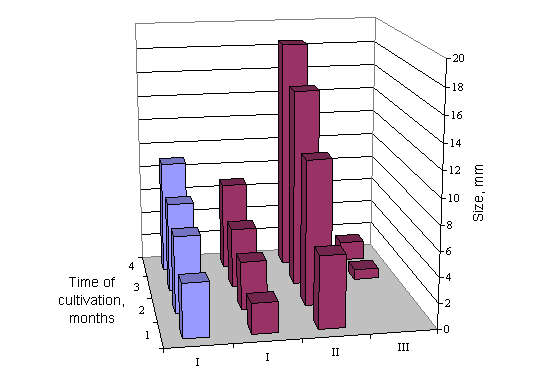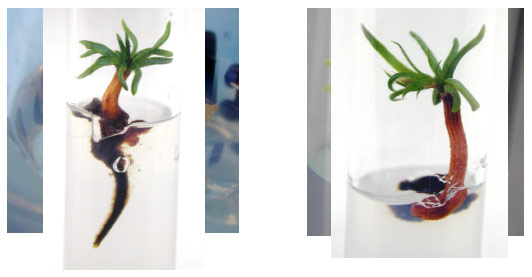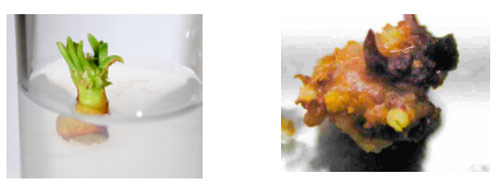

0444-B4
I.N. Tret'yakova, N.V. Novoselova, A.N. Ivanova 1
Siberian coniferous species are the most difficult objects for studying in vitro. The difficulties of introduction in culture of these species are caused by duration of formation of generative organs, weak regenerative ability, formation of immature embryos which need a long stratification (Siberian pine).The experiments in growing seedlings in vitro from fertilizing egg cells and immature embryos of Siberian pine, Siberian larch, Scotch pine and Siberian spruce were carried out. Megagametophytes at different stage of development from archegonium central cell formation to mature embryo of normal and heterosic genotypes of Siberian pine and Siberian larch were placed to the agar MS medium with different concentration of hormones.
The cultivation of megagametophytes have shown, that the egg cell of Siberian pine is in deep rest and can not develops without a trigger (male gametes). An introduction of cytokinines at the stage of mature egg cell, zygote, proembryo, early development of embryo as well as auxins at the stage of embryo differentiation allows to manipulate the embryological processes and formation of plantlets.
The experiments of cultivation in vitro of immature embryo have shown that under-development of Siberian pine embryo is a forced phenomenon. Maturation of embryos and development of plantlets occur in the 7 days instead of 4-5 months of seed stratification.Explants of Siberian pine, Siberian larch and Scotch pine embryo in vitro can form the adventivious buds at the base and the top of cotyledons on the MS medium with BAP (concentration 1-2 mg/l).
The development of anventivious buds in Siberian spruce is observed from cubepidermal cells of hypocotyle on the medium LP with BAP (concentration 1 mg/l). 30-40 bubs on the hypocotyle are observed. Adventivious buds form adventivious shoots and roots after subcultivation on MS medium without hormones. Thus, cultivation of megagametophytes and embryos of Siberian coniferous species is aimed to overcoming sterility of heterosic forms and propagation ofimproving genotypes.Key words: in vitro, megagametophytes, embryo, adventivious bud, Siberian coniferous species
Micropropagation of conifer in vitro goes by formation of adventivious budsand by somatic embryogenesis (Cell and Tissue..., 1987; Woody plants..., 1989). The forest tree species are a very difficult objects for culture in vitro. The problem of conifer species regeneration is connected with their long annual cycle of development with difficulties of vegetative reproduction in mature age. Siberian pine (Pinus sibirica Du Tour) is the main forest forming species in the South Siberian Mountains. Only this species in Siberia produces nuts. The difficulties of introduction in culture of this species are due to the long time of formation of generative organs (the generative cycle proceeds 27 months, ovules develop over 16 months, the period from pollination to fertilization takes 12 months) and to a very weak regeneration. This species forms polyembryonal and immature seeds which need a long stratification (4-5 months).
Among the Siberian pine trees the separate heterosic genotypes with acceleration of generative cycles are met. The morphogenesis of female cones as well as the development of ovules of this species is completed in 1.5-2.5 months after pollination. Seeds become ripe in the late August (in 2.5 months after pollination).
Cytoembryological study of ovules of abnormal genotypes has shown that embryological processes are finished in 1.5-2.5 months after pollination. However, fertilization of abnormal individuals is absent because of the slow growth of pollen tubes The seeds form in 2 months after pollination, but they have not embryo and have a developed endosperm (Tret'yakova, 1990). So heterosic trees of Siberian pine can'not be bred. Thus, seeds of Siberian pine are characterized by incompleted embryogenesis and even go by the full elimination of embryo development stage from embryonal cycle.
The cultivation of megagametophytes of Siberian pine, of Siberian larch (Larix sibirica L.) and Scotch pine (Pinus sylvestris L.) under the control allows to understand the regularities of the forming zygotic embryos and to determine conditions for the process of somatic embryogenesis. Study results of regularities of megagametophytes and immature embryo development as well as the formation of adventivious buds of Siberian coniferous species are shown in this paper.
The objects of study are typical and abnormal (heterosic) trees of Siberianpine, Siberian larch, Scotch pine and Siberian spruce growing in Siberia. The age of trees is 80-100 years. Open pollinated cones were collected from the period of archegonium formation (the early June) to seed maturation (the early September).
Megagametophytes with nucellus and without nucellus as well as isolated embryos were used as the explants for cultivation.Ovules, seeds and embryos were sterilized by iodine solution and washed out in the water. Objects were free from envelopes and placed to the agar MS medium (Murashige, Skoog, 1962) with different concentrations of hormones (IAA, NAA, 2,4D,6-BAP and kinetin) and in different hormone combinations. The cultivation of megagametophytes was realized at the stage of archegonial central cell, zygotes and embryo formation. The cultivation of megagametophytes at the phase of mature egg cell and proembryo was performed in two stages ( Kashin et al, 2000).
The first stage was directed to activation of egg cell division and proembryo formation. At this stage the advantage was given the cytokinines which concentration exceeded the auxin concentration 5 times (medium MS1, MS2). The second stage was a directed to the induction of embryo development.In globular embryo stage and the following stages the advantage was giventhe auxins (mediums MS3, MS4, MS5, MS6) (Table 1).
At the more late stages of embryogenesis development the cultivation of embryos both together with megagametophytes and without them (isolated embryos) was carried out. The cultivation of immature embryos at the stage of their differentiation together with megagametophytes was realized on the mediumMS 5 and MS6. The introduction of immature embryo (the length of axis of embryo is half less than that one of corrosion cavity) was performed on the mediums MS7,MS11. The introduction of immature embryo with megagametophytes and without them takes place on the medium MS11.
The induction of adventivious buds of Siberian pine, Siberian larch and Scotch pine took place on the medium MS8 , MS9. Subcultivaion of adventivious buds took place on the medium MS10. The induction adventivious buds of Siberian spruce took place on the medium LP with BAP (concentration 1 mg/l). The cultures were incubated under the regime of 16 light hours and 8 dark hours, at the temperature 24-26 º C.
Table 1 Examples of MS medium with different hormones (mg/l)
Hormones |
IAA |
α-NAA |
2,4 D |
6-BAP |
Kinetin |
MS1 |
0,1 |
0,5 |
|||
MS2 |
0,2 |
1 |
|||
MS3 |
0,1 |
0,2 |
0,03 |
||
MS4 |
0,1 |
0,2 |
0,03 | ||
MS5 |
2 |
0,2 | |||
MS6 |
1 |
|
0,2 | ||
MS7 |
0,5 |
0,2 | |||
MS8 |
1 |
||||
MS9 |
2 |
||||
MS10 |
2 |
2 |
|||
MS11 |
without hormones | ||||
Samples were fixed in different period development of ovules. The constant preparations were made by cytological methods (Jensen, 1965; Ivanov, 1982). The changes in megagametophytes were found using the light microscopic examining of explants.
The cultivation of megagametophytes of typical and heterosic trees of Siberian pine, Siberian larch and Scotch pine in the period of achegonium central cell formation (5-7 days before fertilization) on the medium MS1, MS2 showed that embryological processes go seldom. Only the growth of callus mass is observed (Fig. 1). Fertilization and embryo development ocurred in 10% explants. Egg cells of isolated megagametophytes (without nucellus) of typical and heterosic trees of Siberian pine can not develop in culture in vitro. These megagametophytes increase their size and keep viability during 3-4 months. Possibly, egg cells of Siberian pine and Siberian larch are in deep rest, so a trigger (male gametes or growth of pollen tubes) is needed to lead out them from this deep rest.
The cultivation of megagametophytes in the period of zygote and proembryo formation on the agar MS1-6 medium with hormones allows to manipulate events of fertilization and embryo development. Embryogenesis is finished, but the formation of seedlings is not observed. In 10 days after fertilization is the most favourable period of cultivation of megagametophytes starts. In this period the introduction of embryo into corrosion cavity occurs and its cleavage is observed. The influence of hormones ( auxins and cytokinins) allows to get polycleavage. Embryos at the stage of five- cell formation finishes embryogenesis and forms seedlings in 2 months. However, these seedlings do not form the roots (Fig. 2).
The cultivation of megagametophytes with immature embryo (embryo at the stage of its early differentiation - 4 weeks after fertilization in Siberian pine and 2 weeks in Siberian larch at the MS5 and MS6 mediums showed that embryogenesis is not stoped. In 2 months on the MS 5 medium and in 3 months on the MS6 medium embryogenesis is finished and roots form. Seedlings have a very well developed cotyledons, hypocotyls and roots.
The cultivation of immature embryo Siberian pine (the length of axis of embryo is half less than that one of corrosion cavity) on MS7, MS11 showed that the revelation of cotyledons is observed already in 2 days.
The development of roots and formation of seedlings occur in 7 days. So, the processes of Siberian pine seed stratification may be replaced by embryo cultivation in vitro. Maturation and growth of zygotic embryos proceeds in 7 days instead of 4-5 months of seed stratification. On the medium MS11 (without hormones) the roots do not develop (Fig. 3b).
The active growth of roots is observed on the MS7 medium. The length of roots was 10-13 mm, the length of epicotyls - 3-5 mm. in 2 months of cultivation (Fig. 3a). The formation of lateral roots ( the length is 0.5-1.0 mm ) occurs in 3 months of cultivation (Fig. 4)

Fig. 4 The growth and development of embryos of Siberian pine culture in vitro.
I - epicotyls, II - roots, III - lateral roots ■ - MS7, ■ - MS11
The cultivation of immature embryos (the length of axis of embryo is half more than that one of corrosion cavity) with megagametophytes on the MS11 (without hormones) resulted in the formation of seedlings in 1 month.
However, isolated embryo on the medium without hormones did not develop seedlings. The intensive formation of callus is observed.
The cultivation of zygotic embryos of coniferous species showed the species specifity of the adventivious buds formation. The development of adventivious buds is observed at the base and at the top of cotyledons (4-10 buds on one cotyledon) in 1.5 months in Siberian pine, Scotch pine and Siberian larch on the medium MS8 and MS9 with BAP (concentration 1 and 2 mg/l) (Fig. 5). The development of adventivious buds in Siberian spruce is observed from cubepidermal cells of hypocotyle on the medium LP with BAP (concentration 1 mg/l). In the 3 weeks 30-40 buds on the hypocotyle is observed. Anatomical study of adventivious buds showed that all the buds which were produced de novo have an identical structure. After subcultivation on MS medium without hormones adventiviuos buds form adventivious shoots . Subcultivation of adventivious buds on the mediums MS10 and MS9 showed the active formation of callus mass (30%). In Siberian pine the meristems (70%) were developed in callus mass in the 2-3 weeks (Fig. 6).
The active morphogenesis goes in these meristems : needle and shoots form. In Scotch pine adventivious buds are form plantlet intensively. In the 2-3 adventivious buds of Scotch pine form shoots and roots.
Thus, the egg cell of Siberian pine is in deep rest and can not develop without a trigger. An introduction of cytokinines at the stage of mature egg cell, zygote, proembryo, early development of embryo as well as auxins at the stage of embryo differentiation allows to manipulate the embryological processes and formation of plantlet.
The experiments of cultivation in vitro of immature embryo have shown that the under-development of Siberian pine embryo is a forced phenomenon.
Under favourable conditions these embryo can form seedlings without stratification.
Explants of Siberian coniferous species embryo in culture in vitro can form the adventivious buds. Subcultivation of adventivious buds on the MS medium (Siberian pine, Siberian larch and Scotch pine) and LP medium (Siberian spruce) with 6-BAP has shown the formation of meristems and shoots.
This study has shown the ability of Siberian coniverous species to develops in vitro. The experiments have shown that the growing seedlings in vitro is observed from the zygotic embryo at the early stage of its formation. Further studies of embryonal processes of Siberian coniferous species in vitro will be aimed at overcoming sterility and incompatibility of heterosic forms and at hybridization.
This work is supported by the Russian Foundation for Basic Research. Grants 02-04-48168
1. Kashin A.C., Bludaeva E.A., Silkin M.A. Activization of megagamet and regularities embryogenesis of infertilized millet ovary in vitro //Plant physiology.-2000.-V.47, N 2.-P.291-301.
2. Murashige T., Skoog F. A revised medium for rapid growth and bioassays with tobacco tissue cultures // Physiol. plantarum. - 1962. - V. 15, N 23. - P. 473.
3. Jensen W.A. Botanical histochemistry Moscow, 1965.- 376 p.
4. Ivanov V.B. Active colors in biology М.: Nauka, 1982. - 214p.
5. Tret'yakova I.N. Embryology of conifers (Physiological aspects)- Novosibirsk, Nauka Siberian Branch, 1990.- 156p.
6. Woody plant biotechnology. Edited by Ahuja M.R.Placerville, California.: Proceedings of NATO Advanced Research Workshop on Woody plants biotechnology, 1989. 373 p.
7. Cell and Tissue culture in Forestry. Edited by Bonga J.M., Durzan D.J. Dordrecht.: Martinus Nijhoff Publishers, 1987. 422 p.


Fig. 1 The cultivation of megagametophyte at stage of achegonium central cell on the medium MS1, MS2. The growth of callus mass is observed
Fig. 2 The cultivation megagametophyte at the stage of embryo five-cell formation on the medium MS3, MS4. Embryogenesis is finished and seedlings are formed in 2 months. Seedlings do not form a roots.
Fig. 3 The cultivation of immature embryo (the length of axis of embryo is half less than the lenght of corrosion cavity) at MS7 (a), MS11 (b) in 2 months
Fig. 5 The development of adventive buds at the base and at the top of cotyle in 1.5 months (MS8, MS9)
Fig. 6 Development of organogenic callus (MS9)
1 Institute of Forest, 660036, Krasnoyarsk, Academgorodok, Russia
e-mail: [email protected]